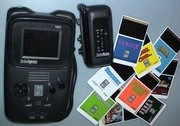
TurboExpress
The TurboExpress or (PC Engine GT in Japan) was a portable version of the TurboGrafx-16/PC Engine, released in 1990 for $249.99 (the price was briefly raised to $299.99, soon dropped back to $249.99, and by 1992 it was $199.99).
It was the most advanced handheld of its time and could play all the TurboGrafx-16's games (which were on a small, credit-card sized media called HuCards). It had a 66 mm (2.6 in.) screen, the same as the original Game Boy, and could display 64 sprites at once, 16 per scanline, in 482 colors from a palette of 512. It had 8 kilobytes of RAM. The Turbo ran its 6820 CPU at 3.58 or 7.16 MHz.
The optional TurboVision TV tuner included RCA audio/video input, allowing you to use TurboExpress as a video monitor. The TurboLink allowed two-player play. Falcon, a flight simulator, included a "head-to-head" dogfight mode that could only be accessed via TurboLink. However, very few TG-16 games offered co-op play modes especially designed with the TurboExpress in mind.
Hardware problems[ | ]
While the system was technologically superior to the other handhelds of its era, it still had its problems. Due to a problem with cheap capacitors, sound failure was a frequent problem with the TurboExpress. Another issue was burned out pixels; due to the quality of LCD technology at the time, the rate of pixel failure was very high. Brand-new TurboExpress systems often had several bad pixels. TurboGrafx-16 HuCards saved game data to the internal RAM memory of the TurboGrafx-CD unit, TurboDuo, or TurboBooster Plus (a peripheral for the core TG-16 console). The TurboExpress lacked this internal RAM memory, and as a result it was not capable of saving. Text was also difficult or impossible to read in certain circumstances, as many times fonts were written to be seen on a television screen, not on a small LCD screen. As a result, certain RPGs and adventure games could be difficult to play on the unit. Another serious problem was that the battery life was only about three hours (for 6 AA batteries), which was also a problem in some other handhelds of the period, such as the Game Gear and Atari Lynx.
Reaction[ | ]
Despite its technical advantages, the Turbo Express was not very popular or known with gamers. In addition to NEC's disastrous marketing, the fact that the handheld was initially released for $299.99 (because of this, it was labelled as the Rolls Royce of handhelds) didn't help matters. Since there were other affordable handhelds and the TG-16 wasn't popular enough to be accessible for the great majority of players, the Turbo Express was targeted mainly to the relatively small number of fans of NEC's systems. The system finally was quietly discontinued around the time the Turbo Duo was also in its twilight. ame.
